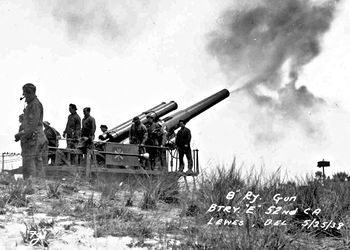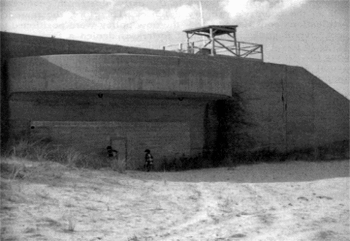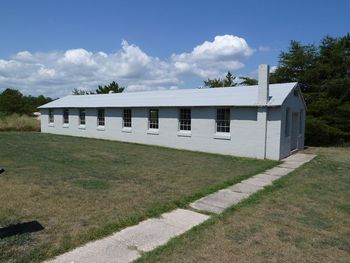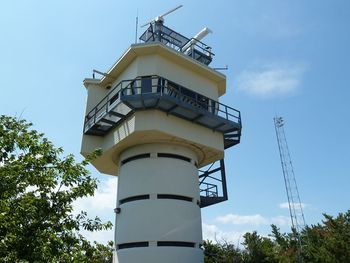Fort Miles
| More information at Warlike, Wikipedia
Fort Miles (1940-1948) Originally established in 1940 as the Cape Henlopen Military Reservation and built out as a Coastal Defense Fort during World War II. Named for Lt. General Nelson Appleton Miles on 3 Jun 1941. The Coastal Batteries declared surplus 5 May 1948.
History of Fort MilesPart of the Harbor Defense of the Delaware. Positioned at the mouth of the Delaware River, Fort Miles provided long range, heavy caliber protection from enemy capital warships as well as rapid-fire protection from fast-moving subs and torpedo boats. It also provided minefield protection, along with searchlight, radar, and anti-aircraft installations throughout World War II. World War II (1941-1945)Fort Miles was originally planned to have two casemated 16" gun batteries, Battery 118 and Battery 119. Battery 119 was canceled and replaced in 1942 by Battery 519 and armed with two 12" guns from Battery Haslet, Fort Saulsbury. Three standard 200 series batteries, each with two 6" rapid fire guns, were built, Battery 221, Battery 222 and Battery 223, as well as three Anti-Motor Torpedo Boat batteries, Battery AMTB 5A - Fort Miles, Battery AMTB 5B - Fort Miles and Battery AMTB 7 - Cape May. Battery 223 and Battery AMTB 7 - Cape May were located on Cape May Military Reservation, a subpost of Fort Miles just across the river entrance at Cape May, New Jersey. The two AMTB batteries on Fort Miles proper replaced an older 3" battery and provided a more reliable, higher rate of fire capability.  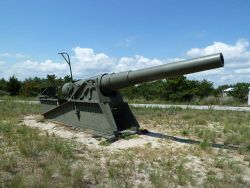 In 1942, with the large caliber batteries under construction, 8" railway guns were brought in as temporary protection for the river entrance. Two sets of four emplacements were built for the 8" railway guns. These emplacements were large U shaped sand revetments with railroad tracks built through the rear. The 16" guns and the eight 8" railway guns gave Fort Miles tremendous firepower and made it a very powerful coastal fort. In 1944, as the permanent batteries came online, the railway batteries were removed.
Fire Control TowersTo support the large caliber batteries at Fort Miles it was necessary to construct a series of sixteen concrete fire control towers along the coast. This was necessary because the range of the 16" guns was far greater than the line of sight required for targeting from the gun batteries. Even with the towers, the line of sight restricted the seaward range of Battery 118 to about 14 miles even though the actual range of the guns was about 25 miles. By stringing the towers along the coast the north-south range of the guns was extended for the full 25 miles. Many of these circular concrete towers still exist and one has been restored and is open to the public. Fire Control RadarIn 1943, five World War II SCR-296-A Radar Sets were installed on Fort Miles and along the coast to provide fire control for the 6" and above batteries in conjunction with the fire control towers. A single SCR-582 radar provided an overall search capability for surface ships and low flying aircraft and gave the nearby HDOP the ability to identify and assign targets to specific gun batteries. With a target assigned, the SCR-296-A radar would track the target and provide range and azimuth readings to the gun battery.
In 1941 a temporary Harbor Entrance Control Post (HECP) was established in the Bell Haven Surf Club just two days before the attack on Pearl Harbor. The permanent location for the HECP was selected as fire control tower #9 and the move was made on 8 Jun 1943. The successor facility still occupies tower #9 today. Fire Control SearchlightsTo provide seaward visibility during nighttime for the fire control towers, 19 large searchlights were positioned along the New Jersey and the Delaware coast. These searchlights could be employed for both surface craft and aircraft. Submarine MinesThe Submarine Mine defense of the entrance to Delaware Bay called for 35 groups of 13 - M4 submarine mines (ground type) planted in three lines. Submarine detection equipment was provided by 3 audio reception systems M1 in one line outside the outer line of mines. Infrastructure to support the minelaying operation included a flotilla of vessels to lay and service the mines, onshore operations to store and arm the mines and storage igloos for the TNT used in the mines. These mines were controlled mines connected by cables to a mine casemate where they were armed and detonated. The mine casemate operation tracked visual and audio observations of vessels approaching the minefields and determined which mines should be armed and fired. The minefields were protected from enemy high-speed minesweeping operations by shore-based smaller caliber (90mm & 3") AMTB batteries with rapid-fire guns, four searchlights, and observation towers. 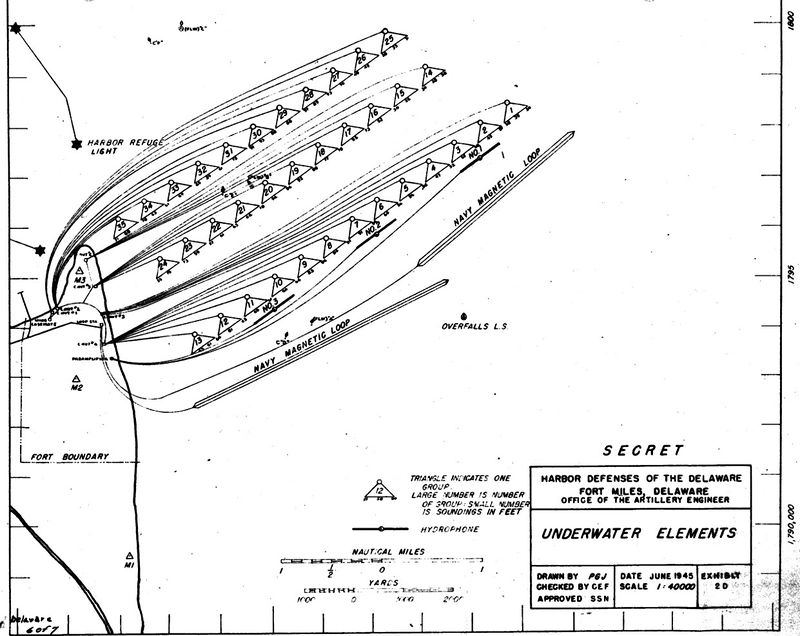 Closure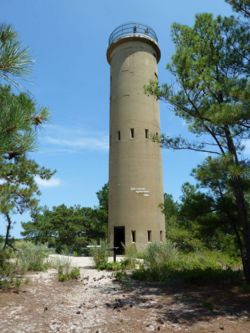 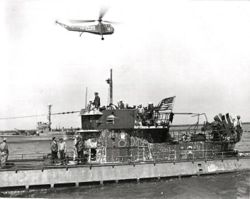 At peak strength, Fort Miles had over 2200 personnel assigned from many different units. To support these personnel several periods of base construction were required, the first in 1940 and another in 1942. Many temporary barracks and other facilities were constructed during these periods and some of these remain today. As World War II came to an end in Europe, Fort Miles played a role the surrender of the German U-Boat U-858. The U-858 appeared off the Delaware coast on 14 May 1945 and U.S. naval forces took her official surrender at sea. The U-858 was instructed to dock at Fort Miles and the German crew disembarked there. In 1948 the coastal batteries of Fort Miles were declared surplus and in 1951 portions of the fort were turned over to the U.S. Navy. In 1961 part of the reservation became Fort Miles Army Recreation Area. Defense Department transferred 564 acres to the State of Delaware for Cape Henlopen State Park in 1964. By 1996 the State Park had acquired almost all of the reservation.
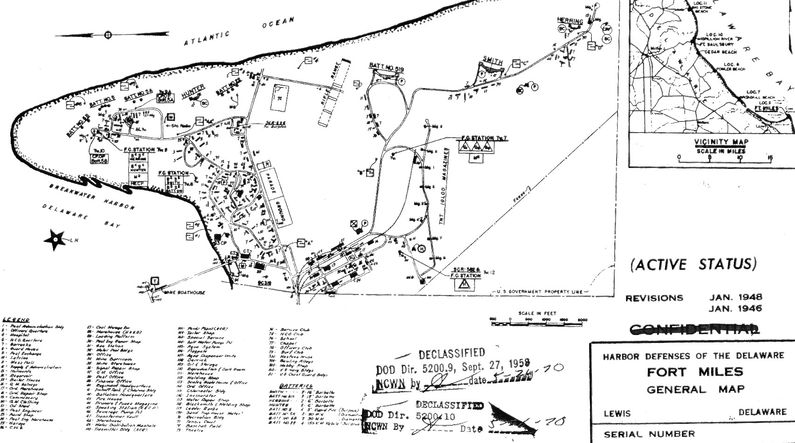
Current StatusMust See! Now Cape Henlopen State Park. This park has many of the World War II gun batteries, observation towers, and underground bunkers still existing and observable. Most of the batteries with underground bunkers are locked up and many of the underground bunkers are buried or sealed. Of the many concrete observation towers that were built for the gun batteries on Fort Miles, most survive and can be viewed up and down the coast. One tower has been restored and one tower remains in service today, serving to manage the port ship traffic. 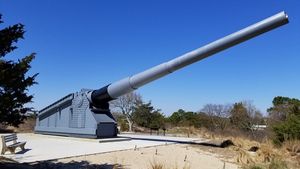  A dedicated group of volunteers has managed over the years to preserve and rebuild a portion of the post that now represents much of the World War II flavor of Fort Miles. The restored facilities include observation Tower #7, a small cantonment area, a series of gun batteries/displays ranging from 3" guns to a 16" gun and a partially restored 500 series gun battery, Battery 519. The focus of this restoration project is a relatively small area between the restored observation Tower # 7 and Battery 519. The cantonment area contains a number of rebuilt WWII style buildings and a number of period guns and mounts on display. The gun and carriage displays have been consolidated into an area including the cantonment area and Battery 519. The outdoor gun displays represent most of the gun types and calibers used at the fort but none of them were actually used at the post. The most spectacular outdoor display is a 16" gun mounted on what looks like a proof carriage located just below the entrance to emplacement #2 of Battery 519. The most important display of the collection is the 12" gun and carriage mounted in emplacement #1 of Battery 519. This display not only includes the mounted gun tube and carriage but also has a functioning breech block. Battery 519 is slated to be a coast artillery museum. Entrance to Battery 519 is by guided tour only, see the Battery 519 page. Do not miss this tour!
See Also: Sources:
Links:
Visited: Apr 2018, 3 Aug 2010
| |||||||||||||||||||||||||||||||||||||||||||||||||||||||||||||||||||||||||||||||||||||||||||||||||||||||||||||||||||||||||||||||||||||||||||||||||||||||||||||||||||||||||||||
